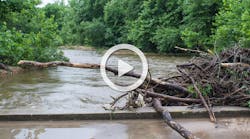Sewers & Drainage: An Integrated Approach
Polluted storm water runoff causes significant human health and water quality concerns. In dense urban environments, these issues are accelerated by combined sewer overflow (CSO) events where rainwater and sanitary water mix.
The expensive long-term solution to CSOs is to separate sanitary and storm sewers by installing new separate piping systems. In an effort to reduce CSOs in the near-term, urban areas increasingly are retrofitting with infiltration-based techniques for keeping untreated runoff from entering the sewer system in the first place. Common examples of infiltration-based green infrastructure practices include rain gardens, bioswales and porous pavement.
Infiltration-based practices are frequently part of a “treatment train” approach in which water moves from one storm water treatment BMP to another and is progressively cleaned before being discharged into the natural environment.
For example, storm water runoff might flow into a mechanical storm water quality unit and then into a storm water pond (two treatments). Or rain might fall onto a vegetated roof, then be piped into an at-grade bioretention cell and finally overflowed into a storm water treatment wetland (three treatments). A treatment train approach is an improvement over simple detention, but still typically relies on pipe and other grey infrastructure techniques to convey water from one BMP to another. In addition, depending on the chosen BMPs, the treatment train approach also can require a significant amount of at-grade area.
An alternative is an integrated systems approach in which several BMPs are combined to capture and treat storm water.
Project Preparation
Lawrence Technological University in Southfield, Mich., is leading a collaboration of industry partners highlighted by Parjana Distribution, which initiated implementation of the project. Surface parking lots represent a significant portion of the impermeable surface found in urban watersheds, but also represent retrofit opportunities to reduce storm water runoff. Hence, this project seeks to create a scalable, integrated drainage system that significantly mitigates parking lot storm water runoff. The first pilot demonstration site was completed in January 2016 at Lawrence Technological University. The pilot project was funded by a Michigan-based nonprofit foundation and through services provided by local industry partners and the city of Southfield.
The project involved retrofitting an existing parking lot drain to mitigate smaller rain events (1 in. or less) that represent the vast majority of rain events, which generate water quality issues associated with storm water runoff. The integrated drainage system includes three patented technologies combined in one approach. The technologies utilized are Xeripave Super Pervious Paver bricks, Haydite lightweight aggregate, and the Energy-passive Groundwater Recharge Product (EGRP).
A Multi-Layer Design
Xeripave pavers represent the initial layer in the system and capture storm water runoff from the parking lot while maintaining parking. The pavers have an infiltration rate of approximately 90 in. per minute, so storm water capture is accomplished by strategically replacing approximately 2.5% of the total asphalt surface area in the vicinity of the existing catch basin. In addition, the paver surface filters out large pollutants that might otherwise flow into the catch basin. Storm water runoff flows through the permeable pavement into an underground porous media reservoir.
The underground reservoir is filled with Haydite lightweight aggregate. Haydite is a manufactured porous ceramic material produced by expanding and vitrifying select shales in a rotary kiln at DiGeronimo Aggregates LLC. The process produces a ceramic aggregate with predictable qualities—lightweight, inert, structurally strong and durable. The aggregate absorbs as much as 24% capillary water by weight and is frequently used as a soil amendment to increase infiltration and water retention. In other applications, it has been shown to improve water quality by capturing suspended solids, hydrocarbons, metals, nitrogen and phosphorus.
The final technology in the integrated drainage system is EGRP. The EGRPs have a 1.25-in. diameter and open chamber neutral pH extrusions, which come in lengths from 5 to 40 ft. EGRPs are capped on the top and vertically inserted 2 ft below grade in a compression augured hole. The EGRP system works with the natural forces of gravity, capillarity, hydrostatic pressure and pore pressure differential to increase the infiltration capabilities of native soils. For this application, the Haydite-filled reservoir was surrounded by 10-ft-long EGRPs spaced every 2 ft and with 20-ft-long EGRPs placed on the reservoir's corners and the midpoint of each side. The EGRPs connect the reservoir to adjacent permeable soil layers, thus draining the reservoir more effectively.
Integrated Future
The project partners believe an integrated systems-based approach for capturing and cleansing storm water runoff is critical for protecting water resources. To prove the concept, performance monitoring included installing shallow and deep water monitoring wells inside, beneath and adjacent to the integrated drainage system to measure water levels for the computation of infiltration. Water quality tests also are being performed on groundwater samples being taken in the wells. In addition, a series of soil moisture and temperature sensors were placed adjacent to the integrated drainage system to determine water flux in the unsaturated zone.
The ultimate plan is for additional sites to be installed in 2016 with targeted locations including Ohio, California, Florida and Washington, D.C. At each site, a parking lot drain will be retrofitted using a similar combination of materials and technologies. After multiple installations and subsequent performance monitoring, Lawrence Technological University expects to establish a national design protocol for advancing this integrated drainage system.
Download: Here


